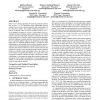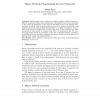31 search results - page 5 / 7 » First-Class Relationships in an Object-Oriented Language |
ECOOPW
1999
Springer
13 years 11 months ago
1999
Springer
The GOODLY language can be used to specify the design of systems built according to the Object Oriented paradigm. It was conceived with the main purpose of facilitating the extrac...
DAGSTUHL
2004
13 years 8 months ago
2004
Abstract. Despite the recent interest for Model Driven Engineering approaches, the so-called four-layers metamodelling architecture is subject to a lot of debate. The relationship ...
SIGMOD
2011
ACM
12 years 10 months ago
2011
ACM
In this work we design algorithms for clustering relational columns into attributes, i.e., for identifying strong relationships between columns based on the common properties and ...
JUCS
2008
13 years 7 months ago
2008
: Implementing binary methods in traditional object-oriented languages is difficult: numerous problems arise regarding the relationship between types and classes in the context of ...
ECOOP
1997
Springer
13 years 11 months ago
1997
Springer
A type inclusion test is a procedure to decide whether two types are related by a given subtyping relationship. An efficient implementation of the type inclusion test plays an impo...


